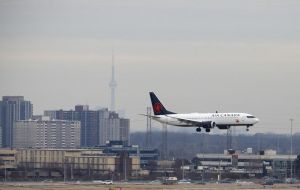MercoPress. South Atlantic News Agency
“Clear similarities” between Boeing 737 crashes in Indonesia and Ethiopia
 Questions have honed on an automated anti-stalling system of the 737 MAX 8, designed to automatically point the nose downward if in danger of stalling
Questions have honed on an automated anti-stalling system of the 737 MAX 8, designed to automatically point the nose downward if in danger of stalling  The disaster caused worldwide grounding of the Boeing 737MAX 8 after regulators noticed similarities with the crash of an Indonesian Lion Air 737 MAX 8
The disaster caused worldwide grounding of the Boeing 737MAX 8 after regulators noticed similarities with the crash of an Indonesian Lion Air 737 MAX 8 Black box data recovered from an Ethiopian Airlines plane that crashed last week shows “clear similarities” with a recent crash in Indonesia of the same type of aircraft, Ethiopia's transport minister said on Sunday.
While declining to give details, Dagmawit Moges told journalists the parallels would be the “subject of further study during the investigation,” with a preliminary report issued in “30 days”.
The announcement came a week after Ethiopian Airlines flight 302 plummeted into a field southeast of Addis Ababa minutes into its flight to Nairobi, killing all 157 people onboard.
The disaster caused the worldwide grounding of the Boeing 737 MAX 8 aircraft involved after aviation regulators noticed similarities with the October crash of an Indonesian Lion Air 737 MAX 8 that killed all 189 passengers and crew.
Both planes reportedly experienced erratic steep climbs and descents as well as fluctuating airspeeds before crashing shortly after takeoff.
Questions have honed in on an automated anti-stalling system introduced on the 737 MAX 8, designed to automatically point the nose of the plane downward if it is in danger of stalling.
The pilots of Lion Air Flight 610 struggled to control the aircraft as the automated MCAS system repeatedly pushed the plane's nose down following takeoff, according to the flight data recorder.
In the case of the Ethiopian flight, the black boxes have been handed to France's BEA air safety agency, which is working with American and Ethiopian investigators to determine what went wrong.
While the cause remains to be determined, Boeing's CEO Dennis Muilenburg on Sunday said the manufacturer is “finalizing its development of a previously-announced software update and pilot training revision” to address behavior of the MCAs “in response to erroneous sensor inputs.”
Experts have questioned the US aviation safety certification process after learning that American pilots had lodged serious complaints about MCAS.
On Sunday the regulator, the Federal Aviation Administration, said it followed “standard” procedures, which “have consistently produced safe aircraft designs,” in certifying the 737 MAX.




Top Comments
Disclaimer & comment rulesCommenting for this story is now closed.
If you have a Facebook account, become a fan and comment on our Facebook Page!